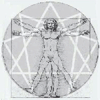“The relation of one cosmos to another is different from the relation of one world to another in the astronomical ray of creation. In the ray of creation worlds are taken in the actual relation in which they exist in the universe for us, from our point of view: the moon, the earth, the planets, the sun, the Milky Way, and so on. Therefore the quantitative interrelation of the worlds one to another in the ray of creation is not permanent. In one case or on one level it is greater, for instance, the relation of ‘all suns’ to our sun; in another case, on another level, it is less, for instance, the relation of the earth to the moon. But the interrelation of the cosmoses is permanent and always the same. That is to say, one cosmos is related to another as ZERO to infinity. This means that the relation of the Microcosmos to the Tritocosmos is the same as that of ZERO to infinity; the relation of the Tritocosmos to the Mesocosmos is that of ZERO to infinity; the relation of the Mesocosmos to the Deuterocosmos is that of ZERO to infinity; and so on. Fragments: Ten
“In order to understand the meaning of the division into cosmoses and the relation of cosmoses to each other, it is necessary to understand what the relation of ZERO to infinity means. If we understand what this means, the principle of the division of the universe into cosmoses, the necessity of such a division, and the impossibility of drawing for ourselves a more or less lucid picture of the world without this division will immediately become clear to us. Fragments: Ten
“First of all we must examine what the ratio of ZERO to infinity means,” I said. “If we understand this, we shall understand the relation of one cosmos to another. In the world accessible to our study we have a perfectly clear example of the relation of ZERO to infinity. In geometry this is the relation of one unit of a certain number of dimensions to another unit of a greater number of dimensions. The relation of a point to a line, of a line to a plane, of a plane to a solid, of a solid, that is, of a three-dimensional body to a four-dimensional body, and so on. Fragments: Ten
“What personally interests me most in this system of cosmoses is that I see in them the full ‘period of dimensions,’ of my New Model of the Universe. It is not merely a coincidence of details — it is absolutely identical. I do not know how it has come about; I have never heard of seven cosmoses related to one another in the ratio of ZERO to infinity. Nevertheless my ‘period of dimensions’ coincides with this absolutely exactly. Fragments: Ten
“The ‘period of dimensions’ contains within itself seven dimensions: The ZERO-dimension, the first, the second, and so on up to the sixth dimension. The ZERO-dimension or the point is a limit. This means that we see something as a point, but we do not know what is concealed behind this point. It may actually be a point, that is, a body having no dimensions and it may also be a whole world, but a world so far removed from us or so small that it appears to us as a point. The movement of this point in space will appear to us as a line. In the same way the point itself will see the space along which it moves as a line. The movement of the line in a direction perpendicular to itself will be a plane and the line itself will see the space along which it moves in the shape of a plane. Fragments: Ten
“As I have said, seven dimensions, from ZERO-dimension to the sixth dimension, constitute the full period of dimensions. Beyond this period there is either nothing or the same period may repeat itself on another scale. Fragments: Ten
“As every cosmos has a real physical existence, every cosmos therefore is three-dimensional for itself or in itself. In relation to a lower cosmos it is four-dimensional, in relation to a higher cosmos it is a point. To put it differently, it is, itself, three-dimensional, but the fourth dimension lies for it in the cosmos above and the cosmos below. This last point is perhaps the most paradoxical, but nevertheless it is exactly as it should be. For a three-dimensional body, such as is a cosmos, the fourth dimension lies as much in the realm of very large magnitudes as in the realm of very small magnitudes; as much in the realm of what is actually infinity as in the realm of what is actually ZERO. Fragments: Ten
Such a succession undoubtedly introduced or maintained a complete incommensurability between the cosmoses, that is, it preserved the ratio of ZERO to infinity. And later this system made possible many very interesting constructions. Fragments: Ten

